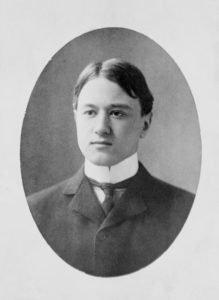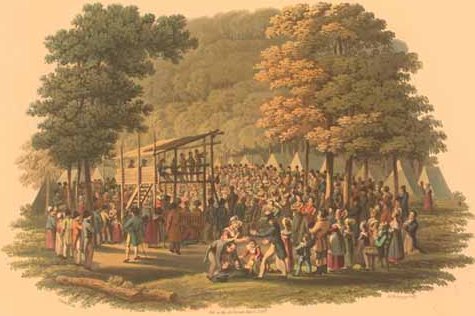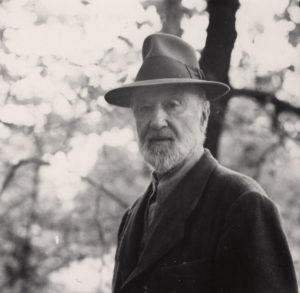
After graduating from Yale in 1898, the young Charles Ives moved to New York City and took up residence with other recent graduates in a series of apartments, each of which was known affectionately as “Poverty Flat.” During the decade between his graduation and marriage, Ives would pursue two careers simultaneously: one as a church organist and another as a marketing strategist for a life insurance company. Despite these time commitments, these would be some of his most productive and experimental years as a composer, although most of his more adventurous works would only be heard by his uncomprehending roommates.
As part of his church duties, Ives would compose many pieces for use during services, although he was usually careful to avoid unconventional sounds, as any trace of experimentation was inevitably met with swift and blunt disapproval from members of the congregation. Toward the end of 1901, Ives composed three such organ pieces: a prelude, a postlude and a piece for communion. These pieces have since been lost (the church tossed out Ives’ music after he stopped working there), but they survive in an elaborated and reworked form as the movements of Ives’ Symphony No. 3: The Camp Meeting.
Childhood Memories
Camp meetings were relics of the early nineteenth-century American religious movement known as “The Great Awakening.” Rural farmers and townsfolk would gather together at a central location to sing, pray and hear circuit preachers sermonize for several days at camps. In an era when the United States was far less developed and densely populated, camp meetings were opportunities for isolated families and communities to worship and socialize together.

As a four-year-old boy, Charles Ives had witnessed one of the last great camp meetings at Redding, Connecticut in 1878. His father, who had been a band master in the Civil War, led the singing of hymns, as Ives later recalled in his Memos:
“I remember, when I was a boy—at the outdoor camp meeting services in Redding—all the farmers, their families and field hands, for miles around, would come afoot or in their farm wagons. I remember how the great waves of sound used to come through the trees—when things like Beulah Land, Woodworth, Nearer My God to Thee, The Shining Shore, Nettleton, In the Sweet Bye and Bye and the like were sung by thousands of ‘let out’ souls. The music notes and words on paper were about as much like what they “were” (at those moments) as the monogram on a man’s necktie may be like his face. Father, who led the singing, sometimes with his cornet or his voice, sometimes with both voice and arms, and sometimes in the quieter hymns with a French horn or violin, would always encourage the people to sing their own way.”
Memories of this early childhood experience were likely the principal inspiration for Ives’ Third Symphony, a work in which the composer would break new ground.
Singing His Own Way
Unlike his First and Second Symphonies, Ives’ Third eschews the usual symphonic structures that had predominated since Haydn and Mozart. Instead, three movements (Old Folks Gatherin’, Children’s Day and Communion) depict various scenes from the meeting, each unfolding organically according to its own, sui generis pattern. In place of the large post-Romantic orchestras of Mahler and Strauss, we have a smaller, quieter chamber orchestra in which the strings prevail, often assuming the role of a singing congregation:
Nearly all of the melodic material in the symphony is derived from traditional protestant hymns tunes, such as Azmon (“O for a Thousand Tongues to Sing”), Woodworth (“Just as I Am”), and Erie (“What a Friend We Have in Jesus”). These melodies are rarely if ever presented straight, however; they are instead fragmented, sepia-toned memories that Ives creates with techniques of musical development used by composers from Bach to Brahms.
Many of the symphony’s other unusual qualities may also have been inspired by the sounds Ives heard at the camp meeting in Redding. The expressive chromatic harmonies may sound reminiscent of contemporary German composers like Strauss and Reger, but it is unlikely that Ives knew their music as it was still rarely performed in America at this time. In addition to being the products of his own musical imagination, Ives’ chromatic harmonies may also be artistic renderings of the way untrained singers often change key in the middle of a song.
Of particular interest are Ives’ “shadow passages,” usually short phrases played by a flute, oboe, or solo violin that clash with the rest of the orchestra. These “shadow passages” may reflect lone voices in the congregation that “sing their own way.” Ever mindful of the difficulty such dissonances posed to his contemporaries, Ives crossed these passages out in his original score, but later indicated that he wanted them put back in. One extended shadow passage occurs at the end of the first movement, played by a solo violin. Perhaps the most magical moment in the score is the ending, in which church bells sound off-stage in a distant key.
“Prizes are for boys!”

While Ives’ contemporaries would have regarded many of the sounds as mistakes, Ives asks us to take them as they are. For him, the sound of the untrained voices at the camp meeting possessed an authenticity and spiritual expression that could not be matched by more ‘correct’ music. Describing the singers at the camp meetings, Ives said, “Most of them knew the words and music (theirs) by heart, and sang it that way. If they threw the poet or composer around a bit, so much the better for the poetry and the music. There was power and exaltation in these great conclaves of sound from humanity.”
When Ives played through his symphony on the piano for friends and acquaintances, it met with universal incomprehension, even without the shadow lines. Ives recalled one typical reaction: “I played over the Third Symphony and Max asked me how I had got so modern??!!” It would only be premiered decades later in 1946 by Lou Harrison and the New York Little Symphony. In the wake of the Great Depression, World War II and far more dissonant examples of modern music, the American musical community finally understood Ives’ nostalgic vision, and the symphony was awarded the 1947 Pulitzer Prize for music. Ives, who had long since given up composing, was unimpressed. “Prizes are for boys!” was his famous response when he learned of the award. –Calvin Dotsey
Don’t miss Ives’ Symphony No. 3, The Camp Meeting November 17, 18 & 19, 2017 at Jones Hall! For tickets and more information, visit houstonsymphony.org.




One response to “Sing Your Own Way: A Guide to Ives’ Symphony No. 3”